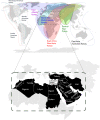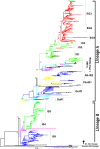A brief summary of the epidemiology and genetic relatedness of avian influenza H9N2 virus in birds and mammals in the Middle East and North Africa
- PMID: 29168447
- PMCID: PMC9148743
- DOI: 10.1017/S0950268817002576
A brief summary of the epidemiology and genetic relatedness of avian influenza H9N2 virus in birds and mammals in the Middle East and North Africa
Abstract
H9N2 is the most widespread avian influenza virus subtype in poultry worldwide. It infects a broad spectrum of host species including birds and mammals. Infections in poultry and humans vary from silent to fatal. Importantly, all AIV, which are fatal in humans (e.g. H5N1, H7N9) acquired their 'internal' gene segments from H9N2 viruses. Although H9N2 is endemic in the Middle East (ME) and North Africa since the late 1990s, little is known about its epidemiology and genetics on a regional level. In this review, we summarised the epidemiological situation of H9N2 in poultry and mammals in Iran, Iraq, Kuwait, Qatar, United Arab Emirates, Oman, Bahrain, Yemen, Saudi Arabia, Jordan, Palestine, Israel, Syria, Lebanon, Turkey, Egypt, Sudan, Libya, Tunisia, Algeria and Morocco. The virus has been isolated from humans in Egypt and serosurveys indicated widespread infection particularly among poultry workers and pigs in some countries. Some isolates replicated well in experimentally inoculated dogs, mice, hamsters and ferrets. Insufficient protection of immunised poultry was frequently reported most likely due to concurrent viral or bacterial infections and antigenic drift of the field viruses from outdated vaccine strains. Genetic analysis indicated several distinct phylogroups including a panzootic genotype in the Asian and African parts of the ME, which may be useful for the development of vaccines. The extensive circulation of H9N2 for about 20 years in this region where the H5N1 virus is also endemic in some countries, poses a serious public health threat. Regional surveillance and control strategy are highly recommended.
Keywords: Avian influenza; H9N2; Middle East; North Africa; genetic analysis; poultry; vaccination.
Figures


Similar articles
-
Natural Reassortants of Potentially Zoonotic Avian Influenza Viruses H5N1 and H9N2 from Egypt Display Distinct Pathogenic Phenotypes in Experimentally Infected Chickens and Ferrets.J Virol. 2017 Nov 14;91(23):e01300-17. doi: 10.1128/JVI.01300-17. Print 2017 Dec 1. J Virol. 2017. PMID: 28931674 Free PMC article.
-
Phylogeographic Dynamics of H9N2 Avian Influenza Viruses in Tunisia.Virus Res. 2024 Jun;344:199348. doi: 10.1016/j.virusres.2024.199348. Epub 2024 Mar 28. Virus Res. 2024. PMID: 38467378 Free PMC article.
-
Phylogenetic analysis and assessment of the pathogenic potential of the first H9N2 avian influenza viruses isolated from wild birds and Lagoon water in Tunisia.Virus Res. 2022 Dec;322:198929. doi: 10.1016/j.virusres.2022.198929. Epub 2022 Sep 17. Virus Res. 2022. PMID: 36126884
-
Challenge for One Health: Co-Circulation of Zoonotic H5N1 and H9N2 Avian Influenza Viruses in Egypt.Viruses. 2018 Mar 9;10(3):121. doi: 10.3390/v10030121. Viruses. 2018. PMID: 29522492 Free PMC article. Review.
-
Current situation of H9N2 subtype avian influenza in China.Vet Res. 2017 Sep 15;48(1):49. doi: 10.1186/s13567-017-0453-2. Vet Res. 2017. PMID: 28915920 Free PMC article. Review.
Cited by
-
Comparison of the Effectiveness of Two Different Vaccination Regimes for Avian Influenza H9N2 in Broiler Chicken.Animals (Basel). 2020 Oct 14;10(10):1875. doi: 10.3390/ani10101875. Animals (Basel). 2020. PMID: 33066560 Free PMC article.
-
Antigenic and molecular characterization of low pathogenic avian influenza A(H9N2) viruses in sub-Saharan Africa from 2017 through 2019.Emerg Microbes Infect. 2021 Dec;10(1):753-761. doi: 10.1080/22221751.2021.1908097. Emerg Microbes Infect. 2021. PMID: 33754959 Free PMC article.
-
Development of an Inactivated Avian Influenza Virus Vaccine against Circulating H9N2 in Chickens and Ducks.Vaccines (Basel). 2023 Mar 5;11(3):596. doi: 10.3390/vaccines11030596. Vaccines (Basel). 2023. PMID: 36992180 Free PMC article.
-
Influenza a virus subtype H9N2 infection induces respiratory microbiota dysbiosis in chickens via type-I interferon-mediated mechanisms.FEMS Microbes. 2025 Feb 3;6:xtaf001. doi: 10.1093/femsmc/xtaf001. eCollection 2025. FEMS Microbes. 2025. PMID: 39991080 Free PMC article.
-
Determining the Protective Efficacy of Toll-Like Receptor Ligands to Minimize H9N2 Avian Influenza Virus Transmission in Chickens.Viruses. 2023 Jan 14;15(1):238. doi: 10.3390/v15010238. Viruses. 2023. PMID: 36680279 Free PMC article.
References
Publication types
MeSH terms
LinkOut - more resources
Full Text Sources
Other Literature Sources

